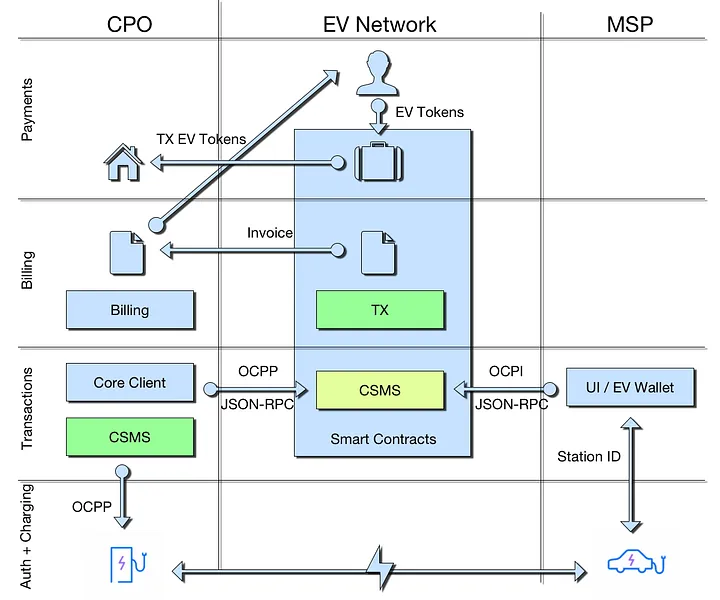This is the second article in a three-part series. If you haven’t yet, read the first post for a breakdown of the current centralized EV charging system and its challenges, including the key roles of the driver, MSP (Mobility Service Provider), CPO (Charge Point Operator), and monthly billing reconciliation.
In this post, we explore a bold reimagining of EV charging infrastructure—from today’s siloed, centralized model plagued by inefficiencies and single points of failure to a decentralized architecture powered by blockchain smart contracts. The goal? A more streamlined, transparent, and autonomous system that favors pre-payment and real-time settlement.
Two Bottlenecks in the Current Architecture
Before we rebuild, let’s pinpoint the core inefficiencies in today’s setup:
- Infrastructure Management
CPOs control the Charging Station Management Systems (CSMS), and every transaction on their networks. This centralized authority creates trust barriers for MSPs who must validate charging sessions for accurate billing. - Payment Processing & Settlement
Currently, MSPs serve as intermediaries, reconciling transactions between drivers and CPOs before issuing monthly bills. This reconciliation is manual, slow, and costly—introducing operational complexity and liquidity delays.
To move forward, we must eliminate these two bottlenecks. By embracing a pre-payment model and decentralized trust, we reduce friction and enable real-time value exchange.
The Building Blocks of a Decentralized EV Charging Network
To replace the current system, we introduce several key blockchain-based components:
- EV Wallet
Integrated with the MSP user interface, this wallet stores tokens and handles charging session requests. - EV Network
A blockchain (e.g., Ethereum) where smart contracts manage charging logic and payment coordination. Think of it as the digital backbone for decentralized EV infrastructure. - Core Client
Software deployed on the CPO side, acting as a translator between the CSMS and the EV Wallet. It enables seamless communication via the EV Network. - Tokens
Used as a digital currency to facilitate payment for energy. Tokens flow from driver to CPO, held in smart contract escrows for real-time, per-session settlement.
A New Charging Journey: Pre-Pay, Plug, Go
Let’s follow the revamped user experience from start to finish, as outlined in the updated system architecture (Figure 2):
- Session Initiation
The driver selects a charging station via the MSP’s app, which connects to smart contracts on the EV Network. - Charging Request
The EV Wallet requests a session through the Core Client, which routes the call to the CPO’s CSMS. All communication is processed via smart contracts, converting OCPP/OCPI into Ethereum’s JSON-RPC. - Transaction Execution
Tokens are locked in an escrow smart contract. Once the charging session completes, tokens are transferred to the CPO’s wallet, and a formal invoice is issued to the driver.
Real-Time Settlement and Trustless Coordination
Gone are the days of monthly reconciliation. Here, each charging transaction is handled in real time, settled atomically, and recorded immutably on-chain. The blockchain itself becomes the new source of truth, removing the need for MSP-CPO settlement agreements.
Shared Authority: A Transitional Step
Although the CPO’s CSMS remains the operational authority on the physical charging process, we introduce a parallel, blockchain-based CSMS that logs authoritative transactions. This hybrid step embeds decentralization into the current ecosystem without disrupting core operations overnight.
What We’ve Achieved So Far
By reengineering the architecture, we’ve:
- Removed intermediaries that drive up costs
- Increased system transparency and automation
- Shifted toward a distributed, token-based, pre-pay system
But we’re not done yet.
In the third and final article, we’ll explore how to move beyond this transitional architecture toward true decentralization, where even governance and infrastructure management evolve to match the promise of Web3 technologies.
